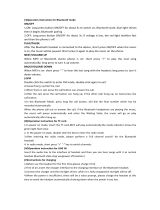
R10_20140702
20
In Now Playing interface, press or pressing the function’s key and or tap
the relevant icons, or slide to Up / Down / Left / Right on screen for the
wanted function. (refer to item D above mentioned functions for reference)
M. Use Bluetooth Menu
In music playing mode (playing a music), then go to Bluetooth menu, tap
it to enter into Bluetooth interface.
1. Turn ON and OFF the Bluetooth Function:
Tap the “OFF” icon on screen, the Bluetooth is turning into “ON” and a
message “Please wait …!” pop up on screen. For few seconds, a “Paired”
interface show “ON” will appear to use;
To turn “OFF” the Bluetooth Function, tap the “ON” icon.
2. Search and Pair with Bluetooth receiver device:
Before pairing, please make sure your Bluetooth Receiver Device supports
Bluetooth A2DP profile.
Keep the device in 1 meter of your Bluetooth receiver device.
Switch on your Bluetooth receiver device and enable it to searching /
pairing mode.
Then, in Paired interface, tap “Scan” icon or slide to left on screen, to start
the scanning function, for approximately 10 ~ 30 seconds; an “Available”
list with found device’s name will appear to choose for pairing.
Tap the wanted “Device Name” in list on screen for pairing, page up the
device name list for looking your desired name of device when necessary,
wait for few seconds both device should be paired, the current playing
music will play automatically from your Bluetooth receiver device, and a
Bluetooth icon “ “is displaying at the right side of chosen device item in
list. Both devices are paired.
3. Change playing music file:
In Bluetooth transmitting mode, exit and go into Music Now Playing
interface for change the playing file if necessary.
In Music Now Playing interface, tap / icon for changing play file.
Tap / icon for pause or play the music.
4. Disconnect with Connected Bluetooth device:
In Paired interface, tap the item of connected device name in list, a dialog
box “Disconnect?” appear to confirm. Tap “Yes” icon to confirm, or “No”
to abort.
5. Unpair with Connected Bluetooth device:
In Paired interface, tap and hold the item of connected device name in list,
a dialog box “Unpair?” appear to confirm. Tap “Yes” icon to confirm, or “No”
to abort.
Bluetooth Function Limitation:
1. Due to the resources control, when you turn the player into Bluetooth audio
transmitting mode, the Video, Picture, Explorer menu etc… cannot be used.






















